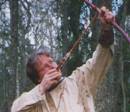 |
Jousi
HTML-kopio vanhasta keskustelualueesta
|
| Näytä edellinen aihe :: Näytä seuraava aihe |
| Kirjoittaja |
Viesti |
Sarka
Liittynyt: 18 Elo 2013
Viestejä: 30
|
 Lähetetty: 12.09.2013 17:28 Viestin aihe: Jänteen mitoitus, poron rumpunahka. Lähetetty: 12.09.2013 17:28 Viestin aihe: Jänteen mitoitus, poron rumpunahka. |
 |
|
Tervehdys!
Tarkoituksena valmistaa poron rumpunahasta jänne.
Kuinka leveää nauhaa ja miten monta kappaletta tulisi leikata yhteen jänteeseen?
Onko kestävyydestä käytännön kokemuksia?
Jousten vetopainot välillä 40-70#
Terveisin
Sarka |
|
| Takaisin alkuun |
|
 |
suomialex

Liittynyt: 06 Maa 2012
Viestejä: 201
Paikkakunta: Stadi
|
 Lähetetty: 12.09.2013 19:14 Viestin aihe: Lähetetty: 12.09.2013 19:14 Viestin aihe: |
 |
|
"Arab Archery" teoksessa on mielestäni aika hyvä ohje vaikka siinä puhutaan kameleista porojen sijaan. Lähde: Arab Archery, N.A. Faris and R.P. Elmer, 1945. The Archery Library.
TRINGS should be carefully made so that they will not stretch in cold weather nor shrink in a warm climate.[45]
They are made of hide, of which the best is that of a lean camel, since such strings, if they are well made, are suitable for all seasons: cold, hot, or otherwise. In case no hide of a lean camel is available, that of a wild ass will do; and in the absence of wild ass hide, that of goats may be used. Goat hide, however, is good only in warm climates and is useless in cold and humid weather since it will then stretch because of dampness.
Strings may also be made of good silk or sinew, both of which are suitable for cold and humid climates but are useless in warm places because they swell up with the heat. Nor are strings made of silk or sinew good for very strong bows. They were, however, used by all the Slavs. Strings may also be made of bamboo, the use of which was current among all the Nubians as well as among many Persians. It is claimed that such strings are very good because they are not affected by climatic changes, though the material is rather brittle and offers the bow little help.[46] Strings may also be made of intestines, the product of which is known as gut string and is good in warm weather only. Cold and damp weather makes them stretch. The best strings, however, are those made of hide since they are good for all kinds of bows, especially those that are hard to draw and are strong of cast.
To make a string, take the hide of a lean camel which has gone hungry through the winter and, therefore, has become emaciated and has not had an opportunity to become fattened at the coming of the spring. The younger the camel, the better is its hide. Soak it in cold water, avoiding completely the use of salt. Then cut it into three sections: the sides making two sections, and the back one. Hang the back section from a piece of wood, weigh it down, and—taking hold of it—scrape it with a sharp metal blade until it is thoroughly cleaned of all flesh. Then cut it in strips twice as wide as the finished string is to be, except that where the hide seems too thin it should be cut a bit wider, and where it is too thick, a bit narrower; because, if it be cut evenly, the thick parts will turn out to be too coarse in the finished product and the thin parts too fine—both of which are serious flaws. Therefore, be careful to cut it out as we have directed, so that the finished string may be even and uniform in thickness. The same operation should be followed with the side sections except that in this case the strips should be cut two and a half times as wide as the finished string.
The string should be coarse in three places; namely, the part whereon the arrow is nocked and the parts which make its two eyes. The strips should then be taken into a dark room where no air penetrates and hung from nails fixed along a board on one of the walls. In the loose end of each strip you cut a hole and insert into it a small piece of wood; then—taking the wood in one hand—start to twist it carefully and attentively, and, at the same time, stretch it out while rubbing it with something rough held in the other hand. When it has been sufficiently twisted and rubbed, weigh it down—the heavier the weight attached to it the better—until it is stretched out to its full limit, and leave it like that for several days until it is completely dry. Then remove and use.
While the hide is still wet, you may make the string by forcing the strip through a small iron ring attached to a strong handle. When making the string by this method, the hide should be cut in strips as wide as the ring itself. After pushing one end of the strip into the eye of the ring, insert into the eye a little piece of wood that is big enough to fill it out, support it with one hand and, with the other, hold the end of the strip and pull at it so as to force the strip through the ring. It will come through cleaned of all flesh and hair. You then finish it in the same manner as the first. |
|
| Takaisin alkuun |
|
 |
Sarka
Liittynyt: 18 Elo 2013
Viestejä: 30
|
 Lähetetty: 12.09.2013 19:59 Viestin aihe: Lähetetty: 12.09.2013 19:59 Viestin aihe: |
 |
|
Kiitos vastauksesta!
kyllä tällä ohjeella pitäisi onnistua.
Artikkelin kakkos osassakin mielenkiintoista tietoa jänteestä
ja jännesolmuista.
Terveisin
Sarka |
|
| Takaisin alkuun |
|
 |
Simo Hankaniemi

Liittynyt: 08 Hei 2004
Viestejä: 4937
Paikkakunta: Turku
|
 Lähetetty: 19.09.2013 18:02 Viestin aihe: Lähetetty: 19.09.2013 18:02 Viestin aihe: |
 |
|
| Raakanahkajänne kannattaa tehdä paksummaksi kuin voisi kuvitella. Se ohenee kuivaamisen ja venytyksen aikana. Jos siitä tulee hieman liian paksu, niin se ei haittaa paljonkaan, mutta liian ohuena se katkeaa tai on koko ajan vaarassa katketa. |
|
| Takaisin alkuun |
|
 |
Sarka
Liittynyt: 18 Elo 2013
Viestejä: 30
|
 Lähetetty: 19.09.2013 18:51 Viestin aihe: Lähetetty: 19.09.2013 18:51 Viestin aihe: |
 |
|
Olisiko heittää vertailumittaa poronrumpunahasta leikattavan nauhan leveydelle? Ja minkälaisen vetopainoa kestänyt käytännössä?
Terveisin
Sarka |
|
| Takaisin alkuun |
|
 |
Simo Hankaniemi

Liittynyt: 08 Hei 2004
Viestejä: 4937
Paikkakunta: Turku
|
 Lähetetty: 25.09.2013 16:34 Viestin aihe: Lähetetty: 25.09.2013 16:34 Viestin aihe: |
 |
|
| En osaa antaa mitään täsmällisiä mittoja, olen tehnyt vain muutaman raakanahkajänteen. Tee vaiston mukaan jonkinlainen jänteenpätkä ja katso millainen tulee. Kokeilunhan ei tarvitse olla täyspitkä jänne. |
|
| Takaisin alkuun |
|
 |
|
|
Et voi kirjoittaa uusia viestejä tässä foorumissa
Et voi vastata viesteihin tässä foorumissa
Et voi muokata viestejäsi tässä foorumissa
Et voi poistaa viestejäsi tässä foorumissa
Et voi äänestää tässä foorumissa
You can attach files in this forum
You can download files in this forum
|
|


